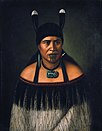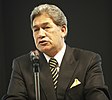Epigraph:
“Indeed, We have sent thee (Muhammad) with the truth, as a bearer of glad tidings and as a Warner; and there is no people to whom a Warner has not been sent.” (Al Quran 35:25)

The Māori settlement of New Zealand represents an end-point of a long chain of island hopping voyages in the South Pacific.
Source: India Weekender and Wikipedia
Indiaweekender: Historic visit to Maori village fulfills prophecy

The arrival of Europeans to New Zealand starting from the 17th century brought enormous change to the Maori way of life. Maori people gradually adopted many aspects of Western society and culture. Initial relations between Maori and Europeans were largely amicable, and with the signing of the Treaty of Waitangi in 1840 the two cultures coexisted as part of a new British colony. Rising tensions over disputed land sales led to conflict in the 1860s. Social upheaval, decades of conflict and epidemics of introduced disease took a devastating toll on the Maori population, which went into a dramatic decline. But by the start of the 20th century the Maori population had begun to recover, and efforts were made to increase their standing in wider New Zealand society. Traditional Maori culture has enjoyed a revival, and a protest movement emerged in the 1960s advocating Maori issues.
In the 2006 census, there were an estimated 620,000 Maori in New Zealand, making up roughly 15% of the national population. They are the second-largest ethnic group in New Zealand, after European New Zealanders (“Pakeha“). In addition there are over 120,000 Maori living in Australia. The Maori language (known as Te Reo Maori) is spoken to some extent by about a quarter of all Maori, and 4% of the total population, although many New Zealanders regularly use Maori words and expressions, such as “kia ora“, in normal speech. Maori are active in all spheres of New Zealand culture and society, with independent representation in areas such as media, politics and sport.
| Prominent Māori, l. to r., top to bottom: Hone Heke and wife • Hinepare of Ngāti Kahungunu • Tukukino • Te Rangi Hīroa • Meri Te Tai Mangakahia • Apirana Ngata • Keisha Castle-Hughes • Winston Peters • Stephen Kearney | ||||||||||||||||||
| Total population | ||||||||||||||||||
|---|---|---|---|---|---|---|---|---|---|---|---|---|---|---|---|---|---|---|
| approx. 750,000 | ||||||||||||||||||
| Regions with significant populations | ||||||||||||||||||
|
||||||||||||||||||
| Languages | ||||||||||||||||||
| Māori, English | ||||||||||||||||||
| Religion | ||||||||||||||||||
| Christianity, Māori religions | ||||||||||||||||||
| Related ethnic groups | ||||||||||||||||||
| other Polynesian peoples, Austronesian peoples |
Categories: Asia










Alhamdolillah zumma alhamdolillah,
the prophecies are coming true but the “muslim” mullahs of pakistan can´t understand this.
Subhaan Allah-e-Wa Behumdehi Subhaan Allah il Azeem!
This is an excellent interaction with the Maoris in NZ. Their welcome tradition and culture are very similar to the neighboring Fijian culture.
Being from Fiji I am exposed to the South Pacific cultures of which Maoris a significant part.
In contrast, though, the Maoris are far more humble, accommodating and hospitable from the little that I observed and learned from some who lived in or visited Fiji as cultural groups. officer.
I pray where we failed in capturing Fijian attention – in part due to our Indian/Pakistani Conservative cultures and the profound impact of Christianity on the Fijians, Inshah Allah Ahmadiyya Muslim Community make a significant progress in NZ and win the hearts of our Maori brothers and sisters.
Additionally, we have failed in inter-marriages with the Fijians due to our prejudices, there will be inter-marriages with the Maoris to pave the way to integrate with AMC and Islam s a whole.
Koya Sahib, I like your comments!
Masha’Allah and Allahuakbar
Allahmdulillah Sumaa Alhamdulillah
In Africa for instance Arab Muslims used to inter-marry, while Indo/Pakistanis did not. That is why they were kicked out of East Africa. Among Ahmadis also inter-marriage with Africans is very rare. It should be encouraged. (Same with Pacific Islanders and others).